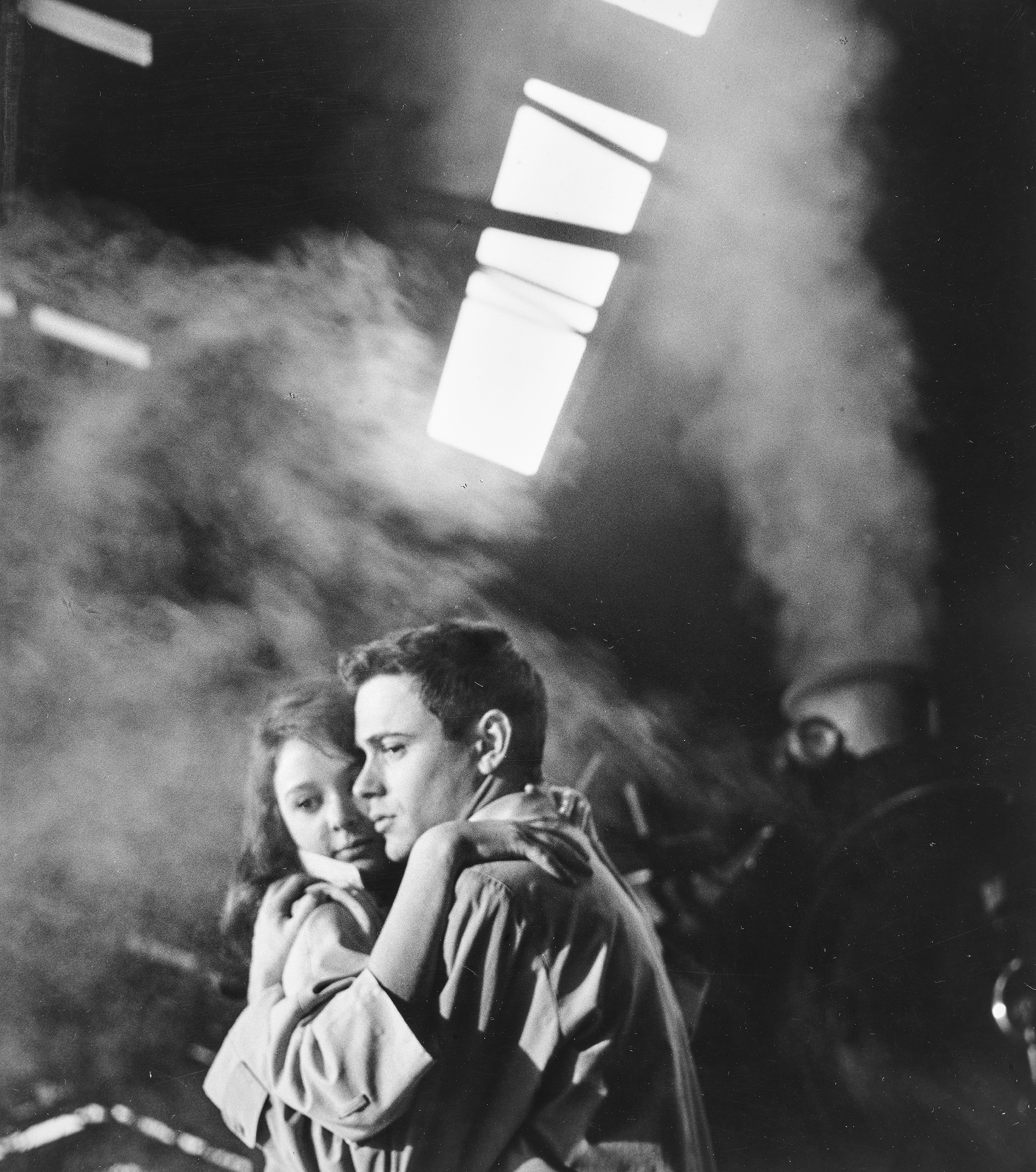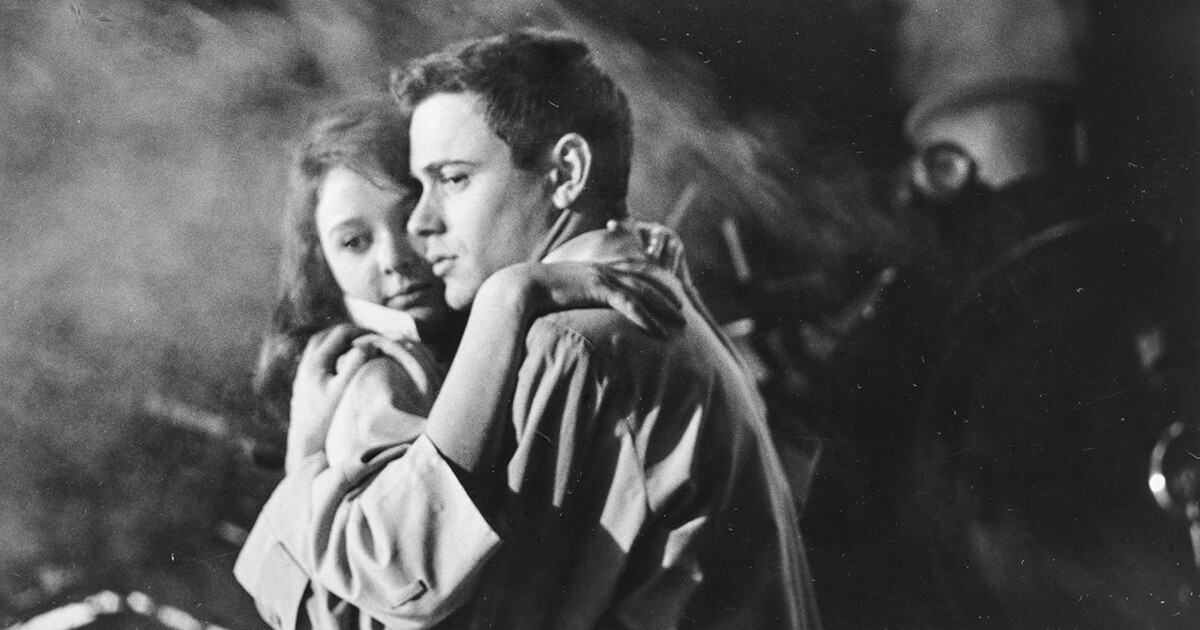
‘Couple dans une gare parisienne’ (1959)
In 1959, the French monthly Réalités ran a piece by Bernard Frank, a precocious novelist and former protégé of Sartre, explaining that a lost generation of young bourgeois had found their bearings in existentialism. Post-occupation and post-Vichy, he argued, the model hero was an impoverished intellectual, the model heroine an affectless free-thinker, and the typical pairing was a relationship in which ‘love’ was conspicuously absent. Réalités hired a promising photographer to illustrate the piece. Agnès Varda had just turned 31; she had held a photographer’s union card for roughly ten years. In her compositions of young lovers in states of suspended affect – on the landing of a gloomy staircase, in the front seats of an open-top car or separated by the windshield of a stationary motorbike – the characters, played by actors, are uneasy and distracted. A couple in a railway station are shown in a tight embrace but remain somehow stranded in their own thoughts. Is one of them returning from a journey or are they saying goodbye? It may not matter. Vapour and smoke from a steam locomotive drift around them.
Le Paris d’Agnès Varda, de-ci, de-là, at the Musée Carnavalet (until 24 August), brings together more than 130 of her photographs and contact sheets, along with notes and jottings, several stills from her films, publicity posters and dozens of photos of Varda herself or her actors on location. Though the show concentrates on Paris there is a wealth of material, which gives an idea of the size of her archive: she travelled widely with two absentee stints in Los Angeles, the first in the late 1960s with her husband, Jacques Demy, the second from 1979 to 1981 during the pair’s brief separation. But Paris was her working milieu for most of her life. She approached it at times like a canny native informant, at others like a child enchanted by a sprawling circus whose routines changed from one arrondissement to the next or season by season. Often she leaned on close acquaintances to divulge the rituals of the city. Her photographs of the young Vilar children – a resolute older sister and two small brothers – on their way to school after the long summer holiday appeared in Marie-France in 1951. Early morning sunlight floods the cobbles; the children are cheerful. Their father is the actor and theatre director Jean Vilar, brother-in-law of Varda’s lover, Valentine Schlegel, a sculptor and ceramicist. Varda’s eye for mises-en-scène was matched by her ability to requisition people she knew – and their children – as players.
She had been living in Paris since 1942 or early 1943, the year before the Liberation. In 1951, with help from her father, she bought part of a property in the 14th arrondissement on the rue Daguerre – named for the photographer Louis Daguerre. The premises, abandoned by Parisian craftsmen, was a set of rundown ateliers around a courtyard and a pair of shuttered shops fronting the road. She reconfigured the framemaker’s shop and adjoining grocery store as comfortable living quarters plus darkroom. Within months of the purchase, she took in a family of Spanish refugees on the upper floor, which later became her studio. Schlegel moved in and used an oven across the way to fire her pieces. She left in 1957; Jacques Demy moved in the following year. By then Varda had a repertoire of characters to work with, including an Italian mother and daughter in an adjoining street with a window onto the courtyard. The ivy had been stripped from the walls; the worst of the debris had been carted away and her neighbours along with her friends (often artists and writers) took their roles in the courtyard, Varda’s informal theatre. In her studio portraits, they are scrutinised like actors auditioning for fresh appearances.
Varda was born in Belgium in 1928; her father was Greek, her mother French. She was nearly twelve when her family fled the German advance in 1940 and ended up in the Mediterranean port of Sète, not far from Montpellier. As she continued tidying up in the rue Daguerre, her thoughts about a full-length feature circled back to Sète and La Pointe Courte, a fishing village on the lagoon. She began shooting in 1954, with no money to speak of and no firm sense of how things would turn out. La Pointe Courte was released to great acclaim in 1956. It’s one of several extramural projects signalled briefly in this very Parisian show. A decade after its release, La Pointe Courte was hailed by the film critic Georges Sadoul as ‘the first film’ of the New Wave. It must have come as news to Varda that she was a member of the all-male club of directors, led by François Truffaut, Claude Chabrol, Jean-Luc Godard, Éric Rohmer and Jacques Rivette, all of whom were contributors to Cahiers du cinéma, which was launched around the time she moved into the rue Daguerre.
Then, in the early 1960s, a new conversation emerged about French postwar cinema and with it a school known as the Left Bank group. Varda was one; Alain Resnais, Jacques Demy and Chris Marker were others; the naturalised French director William Klein – also a photographer – is sometimes included; so is Georges Franju, a documentary filmmaker whose first narrative feature was released in 1959. The core figures of the Left Bank group were more collaborative than the New Wave crew: Resnais and Marker worked together on an anti-colonialist short about African artefacts, Statues Also Die (1953); Resnais edited La Pointe Courte for Varda; Klein made an appearance in Marker’s montage La Jetée (1962); all four joined forces for Loin du Vietnam, an anti-war film released in autumn 1967, weeks before the Tet offensive. Godard and Joris Ivens, the veteran cinematographer of the Spanish Civil War, were also enlisted. Varda’s name appears in the credits but her contribution didn’t make the cut. It was a short sequence, shot in Paris using half-demolished buildings around the city to evoke the effects of Rolling Thunder, the US bombing campaign in Vietnam that began in 1965. There is no trace of Varda’s footage but the show at Carnavalet includes a set of intriguing location stills by her colleague Michèle Laurent that hint at the ambition of the work.
The Left Bank directors were more eclectic than the New Wave cinema nerds, educated in the front rows of their local movie theatres. Did Left Bankers have more time for the contemporary literary scene than these obsessive theoreticians of cinema, as it’s sometimes argued? For Resnais, there was the nouveau roman. For Varda, there was the compelling possibility that images in sequence were comparable to sentences in a passage of good prose. ‘Photo-Écriture’, a section of the show at Carnavalet that tries to unpack her analogy, uses photographs taken in the mid-1950s of Varda’s young niece decked out as an angel with a halo and a pair of white wings. In ‘Un ange passe’ – a subtle mix of picaresque and whimsy – bustling Tante Agnès deposits her niece in various locations around the city to great effect and captures the reactions of startled Parisians along the way. But the idea of images in series as ‘écriture’ makes better sense in cinema than it does in still photography. In a piece for L’Écran français in 1948, the critic Alexandre Astruc predicted that cinema would ‘gradually break free from the tyranny of what is visual … to become a means of writing just as flexible and subtle as written language … no longer a means of illustrating or presenting a scene, but a true act of writing. The filmmaker/author writes with his camera as a writer writes with his pen.’ This appealed to New Wave and Left Bank alike. Varda had a word for it: ‘The rhythm of filming and editing,’ she said, is akin to ‘the way a writer chooses … adverbs, paragraphs, asides, chapters which advance the story or break its flow. In writing it’s called style. In the cinema, style is cinécriture.’ Like Marker, she was a consummate essayist. Even Sans toit ni loi (Vagabond), her box-office hit in 1985, feels like an essay about belonging and exclusion. Varda told Serge Daney that she had tried to deliver something ‘rigorous’ and ‘absolute’ – a piece of exposition. Years later, in an interview with Daniel Trilling for Sight and Sound, she confessed that she was wrong-footed by the film’s success, which gave people ‘unrealistic’ expectations, though it didn’t make raising money any easier.
Paris features in many of Varda’s films, among them her TV documentary Daguerréotypes (1976), shot on the rue Daguerre; L’Une chante, l’autre pas (1977), her intimiste tribute to French feminism; and Les Glaneurs et la glaneuse (The Gleaners and I), an itinerant documentary from 2000 whose striking finale brings her home to the 14th arrondissement. But Cléo de 5 à 7, released in 1962, is the perfect showcase for the city and the centrepiece of the exhibition, which includes Cléo’s itinerary across Paris from first scene to last – 48 locations in all – and superb photos taken during the shoot (though not by Varda). One of them captures Godard and Anna Karina pausing before they resume their roles in the little film that Cléo will watch to while away time before a meeting with her oncologist. Karina is having her hair adjusted by a make-up artist; both she and Godard are smoking. He is got up in shades, boater and bowtie, she is in white, just as they appear in the film within a film.
